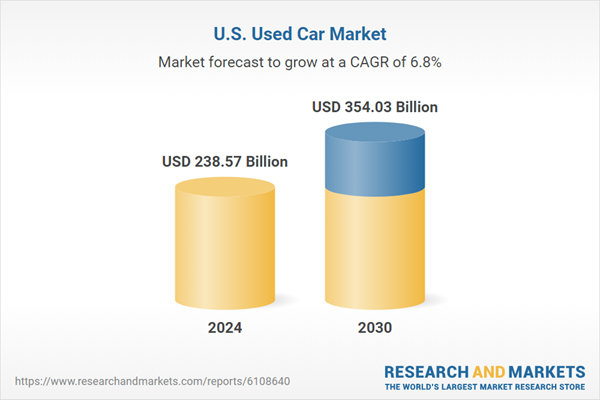Speak directly to the analyst to clarify any post sales queries you may have.
10% Free customizationThis report comes with 10% free customization, enabling you to add data that meets your specific business needs.
This policy shift is anticipated to divert consumer demand toward more affordable pre-owned vehicles, significantly boosting interest in the used car segment. The rising preference for budget-friendly personal transportation, supported by accessible financing and expanding digital retail platforms, is driving market expansion. Digital channels now offer greater transparency, including vehicle history reports and online financing, which enhance buyer trust. Moreover, the increasing popularity of certified pre-owned (CPO) vehicles - offering inspection-backed warranties - continues to attract consumers seeking reliability without the cost of a new vehicle.
Key Market Drivers
Expanding Digital Ecosystem and Online Marketplaces
Digitalization is revolutionizing the U.S. used car market, with online marketplaces offering unprecedented convenience, accessibility, and consumer empowerment. Platforms like Amazon Autos - launched in partnership with Hyundai - are reshaping the buyer journey by enabling customers to browse inventory, secure financing, and schedule delivery or pickup entirely online.These platforms provide access to vehicle listings with detailed specifications, price comparisons, and verified history reports, streamlining the decision-making process. The availability of e-commerce features like instant booking, digital documentation, and home delivery has not only enhanced convenience but also broadened market access for remote and time-constrained buyers. By eliminating traditional friction points in vehicle transactions, online channels are reshaping consumer expectations and accelerating used car adoption.
Key Market Challenges
Inconsistent Vehicle Quality and Limited Standardization
A major obstacle within the U.S. used car market is the inconsistent quality of vehicles, which stems from wide variability in usage history, maintenance practices, and prior damage. Buyers often face difficulties evaluating whether a listed vehicle provides genuine value or conceals underlying mechanical issues. While certified pre-owned (CPO) programs help mitigate this risk, they only represent a small portion of the total inventory. Most private and non-certified listings lack uniform inspection or quality benchmarks. Furthermore, vehicle history reports may not fully capture hidden damage or tampering. This lack of standardization increases buyer hesitation and prolongs the purchase cycle. Although AI-driven diagnostics and predictive maintenance tools show promise in standardizing evaluations, their industry-wide adoption remains in early stages.Key Market Trends
Integration of AI and Predictive Analytics in Vehicle Valuation
Artificial intelligence and predictive analytics are emerging as transformative forces within the U.S. used car market, enabling real-time and highly accurate vehicle valuation. These technologies process vast data sets - including market fluctuations, regional demand, historical depreciation trends, and vehicle condition metrics - to deliver dynamic pricing models.For buyers, this means more confidence in fair pricing and fewer surprises during negotiation. AI-powered recommendation engines now suggest suitable alternatives based on user preferences, usage behavior, and risk profiles. Meanwhile, dealers and lenders leverage predictive tools to assess inventory turnover, identify high-retention vehicles, and evaluate financing risk. These innovations not only enhance operational efficiency but also contribute to increased trust and transparency, positioning AI as a cornerstone of future market practices.
Key Market Players
- CarMax, Inc.
- Carvana Co.
- CarBravo
- AutoNation Inc.
- Sonic Automotive
- Berkshire Hathaway Automotive (Van Tuyl Group)
- Group 1 Automotive Inc
- Asbury Automotive Group
- Hendrick Automotive Group
- Lithia Motors Inc.
Report Scope:
In this report, the United States Used Car Market has been segmented into the following categories, in addition to the industry trends which have also been detailed below:United States Used Car Market, By Vehicle Type:
- Hatchback
- Sedan
- Sports Utility Vehicle (SUV)
- Multi-Purpose Vehicles (MPVs)
United States Used Car Market, By Vendor:
- Organized
- Unorganized
United States Used Car Market, By Sales Channel:
- Online
- Offline
United States Used Car Market, By Region:
- Southeast
- Southwest
- West
- Northeast
- Midwest
Competitive Landscape
Company Profiles: Detailed analysis of the major companies present in the United States Used Car Market.Available Customizations:
With the given market data, the publisher offers customizations according to the company’s specific needs. The following customization options are available for the report.Company Information
- Detailed analysis and profiling of additional market players (up to five).
This product will be delivered within 1-3 business days.
Table of Contents
Companies Mentioned
- CarMax, Inc.
- Carvana Co.
- CarBravo
- AutoNation Inc.
- Sonic Automotive
- Berkshire Hathaway Automotive (Van Tuyl Group)
- Group 1 Automotive Inc
- Asbury Automotive Group
- Hendrick Automotive Group
- Lithia Motors Inc.
Table Information
| Report Attribute | Details |
|---|---|
| No. of Pages | 85 |
| Published | July 2025 |
| Forecast Period | 2024 - 2030 |
| Estimated Market Value ( USD | $ 238.57 Billion |
| Forecasted Market Value ( USD | $ 354.03 Billion |
| Compound Annual Growth Rate | 6.8% |
| Regions Covered | United States |
| No. of Companies Mentioned | 10 |









